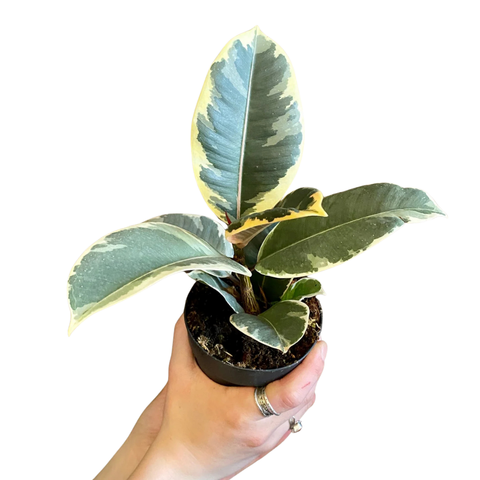
Ficus elastica 'Tineke'
Aroma Quartz📦 FREE SHIPPING OVER £40
Ficus elastica 'Tineke'
Common Names: Variegated Rubber Plant, Rubber Tree, Ficus Tineke
Full Botanical Name: Ficus elastica 'Tineke'
Country and/or Region of Origin: Native to Southeast Asia, particularly India, Indonesia, and Malaysia.
Overview
With its creamy-white, green, and soft-pink marbled leaves, Ficus elastica ‘Tineke’ is a bold and striking statement plant. A more colorful cousin of the classic Rubber Plant, 'Tineke' adds a contemporary feel to any room with its sculptural form and glossy, variegated foliage. It’s relatively low-maintenance, air-purifying, and perfect for anyone wanting to elevate their indoor jungle with something a little more unique.
Growing Conditions in Native Habitat
In the wild, Ficus elastica grows as a large tree in warm, tropical climates—often found in forests with high humidity and bright, filtered light.
Care Guide
Light: Thrives in bright, indirect light to maintain its variegation. Can tolerate medium light, but colors may fade in low-light conditions.
Ideal Room: A sunny living room or hallway with lots of natural light makes the perfect home for this beauty.
Feeding: Feed monthly during spring and summer with a balanced liquid fertilizer to support healthy growth and vibrant foliage.
Humidity: Prefers moderate humidity but adapts well to normal indoor conditions. Misting occasionally or placing near other plants can be beneficial.
Ideal Temperature: Keep between 60–85°F (16–29°C). Protect from cold drafts and sudden temperature changes.
Watering: Water when the top 1–2 inches of soil feel dry. Avoid overwatering—this plant prefers to dry out slightly between waterings. Reduce watering in winter.
Pet/Child Safe: No. The sap is toxic if ingested and may cause skin irritation. Keep out of reach of pets and children.
Soil Type: Use a well-draining potting mix. A blend of peat, perlite, and pine bark is ideal to prevent soggy roots.
Propagation: Propagate via stem cuttings with at least one node. Allow cuttings to callous before rooting in water or moist soil.
Eventual Height and Spread: Indoors, can reach 2–3 metres tall with time and care. Can be pruned to maintain a more compact shape.
Growth Rate: Moderate to fast in optimal conditions. Growth will slow in lower light or cooler seasons.
Pests and Treatment: May occasionally attract scale or spider mites. Treat with neem oil or a gentle insecticidal soap if needed.
Repotting: Repot every 1–2 years or when rootbound. Choose a pot with good drainage and go up just one size to prevent overwatering issues.
Pruning: Prune in spring to shape or control height. Always wear gloves when pruning to avoid irritation from the milky sap.
Air Purification: An excellent air purifier, removing toxins like formaldehyde from the air—great for improving indoor air quality.
Folklore: Ficus plants are considered symbols of abundance, endurance, and growth in various cultures, often associated with good luck and prosperity when kept indoors.
